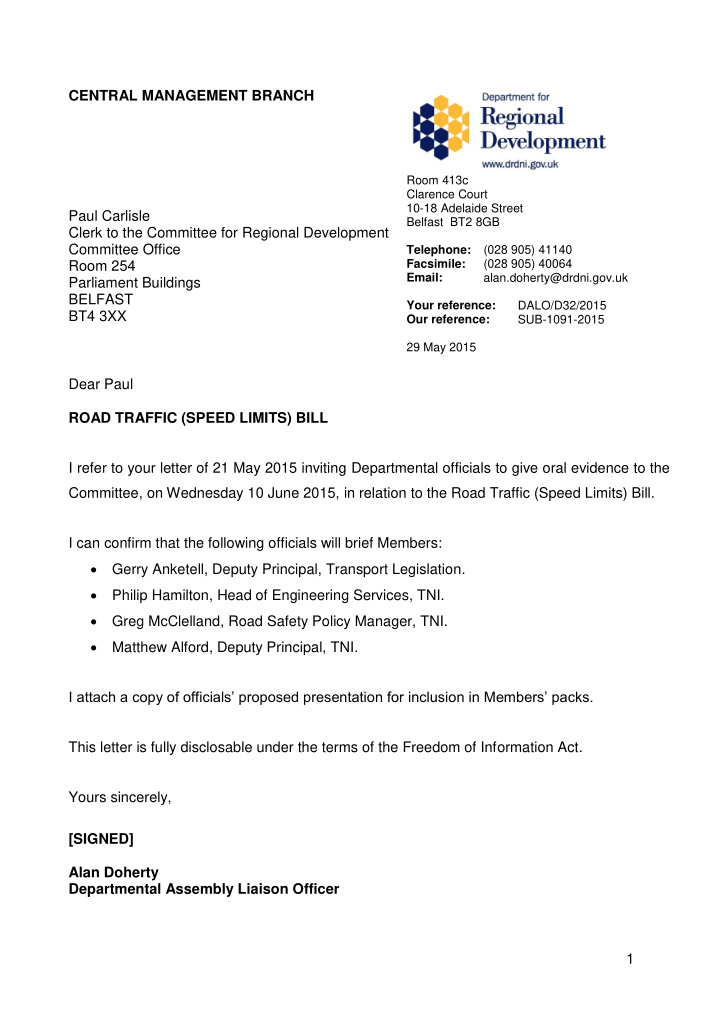



CENTRAL MANAGEMENT BRANCH Room 413c Clarence Court 10-18 Adelaide Street Paul Carlisle Belfast BT2 8GB Clerk to the Committee for Regional Development Committee Office Telephone: (028 905) 41140 Facsimile: (028 905) 40064 Room 254 Email: alan.doherty@drdni.gov.uk Parliament Buildings BELFAST Your reference: DALO/D32/2015 BT4 3XX Our reference: SUB-1091-2015 29 May 2015 Dear Paul ROAD TRAFFIC (SPEED LIMITS) BILL I refer to your letter of 21 May 2015 inviting Departmental officials to give oral evidence to the Committee, on Wednesday 10 June 2015, in relation to the Road Traffic (Speed Limits) Bill. I can confirm that the following officials will brief Members: Gerry Anketell, Deputy Principal, Transport Legislation. Philip Hamilton, Head of Engineering Services, TNI. Greg McClelland, Road Safety Policy Manager, TNI. Matthew Alford, Deputy Principal, TNI. I attach a copy of officials’ proposed presentation for inclusion in Members’ packs. This letter is fully disclosable under the terms of the Freedom of Information Act. Yours sincerely, [SIGNED] Alan Doherty Departmental Assembly Liaison Officer 1
Road Traffic (Speed Limits) Bill 1
Road Traffic (Speed Limits) Bill • The Department fully supports the drive to improve safety on our roads. • Minister Kennedy supported the aims of the bill during the 2 nd Stage Debate. • DRD is a primary stakeholder in Northern Ireland’s Road Safety Strategy along with DOE and PSNI. • In the last 10 years DRD has spent £230m specifically on Local Transport and Safety Measures. • Almost 500 20mph zones have been created - targeted measures, engineered to maximise benefits. • We want to provide communities with the choice to opt in to 20mph limits rather than impose them. 2
Existing Powers We can do this using existing powers - Part VI of the Road Traffic Regulation (Northern Ireland) Order 1997. In most urban areas the speed limit is 30 but DRD can change this desired Department has the flexibility to establish the speed limit on any road; Permanently During specified periods When indicated by traffic signs 3
M1 / Westlink Variable Speed Limits 4
M1 / Westlink Variable Speed Limits This order;- applies a speed limit of 30mph on the length of road exiting from Great Victoria Street station; and applies a 50mph speed limit on Westlink from it’s junction with the M1 at Broadway roundabout to its junction with York Street. The order also introduces variable speed limits between M1 at Blacks Road and the Clifton Street Junction on Westlink. Vehicles may not be driven at a speed above the maximum indicated by a traffic sign. 5
Part Time Speed Limits These orders introduce a part- time speed limit on the lengths of road specified in a schedule. They permit the national speed limit on that length of road, for example, adjacent to a school to be reduced to 20 miles per hour, when a 20 miles per hour limit is indicated by a traffic sign. 6
Current Policy The Department’s policy, “Setting Local Speed Limits in Northern Ireland” encourages and supports 20 mph limits and zones where there is a particular risk to vulnerable road users, especially in residential areas. Factors such as average speed, collision history, streetscape, community support, function and demographics are used to assist in decision making process. The favoured solution has been to install engineering measures, such as road humps and central islands, so the reduced speed limit is, in effect, self enforcing. 7
20mph Zones v’s Limits 20mph zones use 20mph limits use physical measures traffic regulation such as humps, orders signified by the chicanes and gateway use of 20mph signs, features to achieve without physical speed reduction measures. 8
Research on Zones & Limits Studies carried out by Transport Research Laboratory (TRL) into the relative impacts of zones and limits has concluded that; • Zones reduced average speed by 9 miles per hour; • the annual total of accidents had fallen by 60%; • accidents involving children had fallen by 67%; • incidents involving cyclists had fallen by 29%; • the use of 20mph signs alone, without associated traffic calming methods, led to speed reductions, but of a much lesser magnitude than those achieved through traffic calming. 9
Impact of the Bill • If the proposed Bill is approved by the Assembly, it will have resource implications for DRD. • Those areas where the 20mph limit would apply would need to be signed with 20mph limit signs. • Any lengths of road where a 30mph limit would still apply would then require to be signed up to 30mph, with repeater signs possibly being required at regular intervals. 10
Black dots represent signing locations 11
Financial Implication • Portsmouth Scheme cost £573k/410km • Edinburgh Scheme cost £214k/40km • NI Urban Unclassified 4300km • Using this benchmark would produce a NI figure of between £6m and £26m. • Spending this money as the bill intends will reduce the funding available on other Road Safety Related activities which have proven benefits 12
Preferred Approach • Views expressed in the mixed response to the Committee’s call for evidence reflects the debate taking place in GB • DRD approach accommodates this debate facilitating the introduction of 20mph limits by consensus. • 20mph limit pilot projects being implemented to test the NI experience. • Monitor pilot sites in conjunction with similar pilots being undertaken in Scotland, Wales and Ireland. • Use results to consider roll-out of further 20mph limits in areas where there is a community desire. 13
Questions? 14
Recommend
More recommend